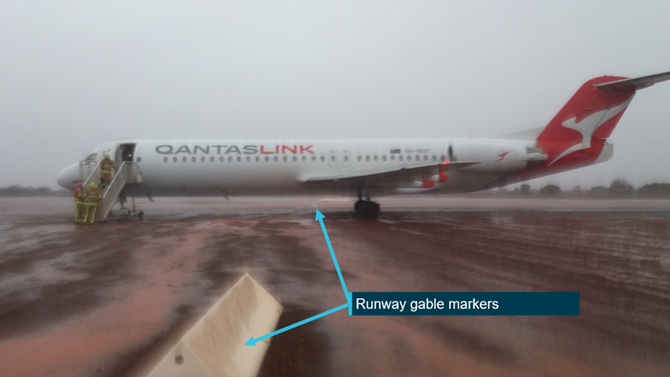QantasLink runway overrun has lessons for pilots
01 September, 2021
3 min read
By joining our newsletter, you agree to our Privacy Policy


Pilots have received new guidelines on landing in wet conditions after a Fokker 100 aquaplaned and ran past the end of a runway in Western Australia’s Pilbara region last year.
The jet operated by Qantas subsidiary Network Aviation landed in wet weather at Newman Airport and ended up stopping 70 metres beyond the runway threshold but inside the runway end safety area.
None of the five crew and 88 passengers were injured in the January 9, 2020 incident but there was damage to tyres and some landing gear components.
READ: Virgin offers a million frequent flyer points in COVID jab jamboree
An Australian Transport Safety Bureau report found that a higher-than-normal approach speed made necessary by prevailing winds combined with poor braking effectiveness on the wet runway to cause the overrun.
It also found an examination of the runway prior to the overrun had found it required maintenance to ensure an adequate level of surface friction but this had not been done.
At one stage the aircraft aquaplaned – sliding on a thin film of water between the runway and the tyres — hampering its ability to brake and forcing the crew to adopt procedures to maintain control.
The pilots were aware the inclement weather could cause problems after receiving a weather report indicating heavy rain, moderate to severe turbulence below 5000 ft and a 25-knot crosswind.
There had been 88mm of rainfall since 9 am the previous day but the ATSB found they had not discussed the wet runway's potential impact on stopping distance.
Instead, they focussed on cloud base and the visibility needed to conduct the approach as well as the expectation of wind shear, turbulence and a strong crosswind.
The followed guidance for expected turbulence, including a faster than normal approach speed, and touched down with an airspeed of 154knots.
“The aircraft did not slow after crossing the runway threshold, or during the flare, and a higher ground speed than airspeed was recorded, indicating a possible unforecast tailwind component,” ATSB director transport safety Stuart MacLeod said.
The ATSB said recorded flight data was consistent with aquaplaning and the captain, sensing this was happening, applied a technique to maintain directional control.
This involved reducing manual braking with the intent of regaining traction, stowing the thrust reversers to increase directional stability and then applying maximum reverse thrust.
“Given the magnitude of this overrun it is highly likely that had the landing speed been reduced, or the braking effectiveness had been normal, or there had been less crosswind, the overrun would not have occurred,” Macleod said.
The ATSB found at the time of the incident neither the operator nor the Civil Aviation Safety Authority had guidance to allow flight crews to determine if the runway was contaminated.
Moderate and heavy rain were not identified as possible runway contaminants, Macleod said.
Network subsequently circulated additional guidance and procedures to flight crew for identifying runway water contamination and to ensure appropriate speed control on approach and landing.
CASA also published guidance reflecting research on ungrooved runways by the US Federal Aviation Administration.
“Water on an ungrooved runway can significantly reduce the ability of an aircraft to slow down,’’ MacLeod noted.
“Operators and pilots are encouraged to review the latest guidance and tools available in relation to maintaining safety on runways and the factors that cause runway overruns.”
Get the latest news and updates straight to your inbox
No spam, no hassle, no fuss, just airline news direct to you.
By joining our newsletter, you agree to our Privacy Policy
Find us on social media
Comments
No comments yet, be the first to write one.

